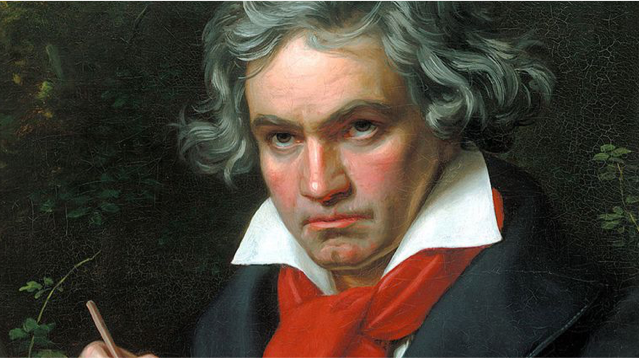A Request to the BPO

We are just a few days away from our first rehearsal of the most challenging piece of the year, one of the most challenging in the repertoire.
You probably have heard the story of when Schuppanzigh, the leader of Beethoven’s orchestra, complained that he couldn’t play a passage, Beethoven apparently responded: “What do you think I care for your lousy fiddle when the spirit is upon me?”
Most of you are aware that some of Beethoven’s demands are so extreme, or sometimes so bewildering, that many musicians have given up trying to make sense of the metronome marks. The great English conductor, Sir Colin Davis, an old friend from my life back in England, once pointed to the Funeral March of the Eroica and said: “Ben, there’s the proof that his metronome marks are nonsense. You couldn’t possibly have a funeral march that goes at 80 to the eighth note. No one walks that fast at a funeral!” “But Colin”, I responded, “he didn’t mean 80, he meant 40.” “Well, if he meant 40, why didn’t he write it?”
“Because he didn’t have 40 on his metronome, 50 was the lowest number.”
Quarter note = 40 is perfectly reasonable for a slow, ceremonial march, but at that “fast” tempo it is extremely hard to capture the appropriate funereal mood. Norman Del Mar in his excellent book on conducting Beethoven writes:
The printed metronome mark of eighth=80 for the Marcia funebre is very nearly twice too fast for any interpretation which is to convey the epic quality of this music…..if the profoundly tragic opening and equally its return at the Minore of bar 105 are to be played with any realization of the music’s sense of utter desolation it can hardly be taken faster that eighth = 48.
Wow!! To play the opening of the movement at that ultra slow tempo would necessitate moving the tempo considerably at the maggiore (bar 69), which must clearly be felt in 2, and then speeding it up even more for the great fugue (114 ff) which most conductors have found only really releases its full intensity at at least quarter = 40. I believe we can achieve the required “mood of utter desolation” at the beginning of the movement (and similar places), in 2 at quarter = 40, while maintaining a pretty constant tempo throughout the movement,(which, surely, is expected in a march), but it is going to take all our collective artistry and singleness of purpose. I have never completely achieved that in any of my past performances, nor, as far as I know, has anyone else. That will be one of the things we will start working on next Tuesday in the string rehearsal.
If you want to hear the Romantic approach that Del Mar is pointing to, listen to the legendary and deeply moving Furtwängler performance (1944) which presents, not a funeral march in 2, but a gorgeous slow orchestral aria in 4. Furtwängler then dramatically increases the tempo to over 90 (!) for the great fugue. Or if you want to hear an attempt at realizing Beethoven’s tempo, listen to Paavo Jarvi and his wonderful chamber orchestra in Bremen. It is at Beethoven’s tempo, but it would probably be scorned by Del Mar and those who see this movement as one of the greatest expressions of public grief in all of Western art. That is the ultimate test of the slow movement.
Now you know something about what I have been wrestling with over the holidays!
The first movement also presents enormous problems. Beethoven’s marked tempo of 60 to the bar is so fast that it borders on frenetic hysteria, rather than the furious energy of the hero. I have continued to experiment with the idea of “tempo rubato” (or tempo modification) which we explored so successfully in both Bruckner 8th and Brahms 4th. With some carefully managed “tempo rubato”, somewhere between MM = 52 and 59, I think we can project the sweeping confidence and exultant joy, as well as the terrible struggle with the forces that beset the hero AND the moments of mystery, calm and gentleness that are part of the full portrait presented in the movement.
Leonard Bernstein claimed that the first two movements of the Eroica are the two greatest symphonic movements ever composed. To do all of what I just described is the hardest test I have ever faced as a conductor. The closest I have come is in a performance with the Israel Philharmonic. I am hoping we can come even closer to Beethoven’s vision on February 6th.
The Scherzo raises no controversy over tempo, because conductors all take the movement at very close to the tempo that Beethoven marked.
Have you ever wondered why the tempo of Beethoven’s scherzos win universal approval, whereas so many other movements are deemed “impossible” “ridiculous” “twice too fast”etc.
The thing that makes the Scherzo extremely hard is the absolute precision required for every single bar, nay every single note. Try playing it with a metronome at 116-120 and see how difficult it is to stay with the metronome. Then try doing that in a true pp!
The Finale presents the biggest problem of all. It is marked 76 to the bar, which is, by all accounts, impossibly fast. What should we do?
As some of you know, I have issued a recording of Beethoven’s Ninth with the Philharmonia Orchestra, together with a two-and-a-half hour explanation of the rationale behind each of the 14 metronome marks in the piece. (Alfonso will send you a link to it when he has down-loaded it, for any of you who can find the time to listen to it) In my discussion I demonstrate that all the tempi in the Ninth are both playable and effective, but I cannot say the same for the last movement of the Eroica. My attempts to perform the Finale have so far failed to realize the desired result.
When the edited recording with the Philharmonia for release on Telarc arrived for my final approval, I balked and rejected it, largely because of the last movement. It has never been issued. However, I think by allowing some “tempo rubato” we might be able to make this miraculous variation movement work. Who, after all, said that a variation movement has to be all in one tempo? We know that Beethoven played very freely in his performances on the piano, perhaps we can do that in this performance.
The Fugue at Letter A works wonderfully at around 72 and I have found that when I imagine nudging the tempo forward just a tiny bit in the bars leading into Letter C, the Hungarian March with dotted rhythms fairly leaps off the ground, at just about 76, with the foot stamping in each bar. Perhaps that was the passage that Beethoven was looking at when he established the metronome mark of 76. But surely when the beautiful oboe theme returns (this time in the flute), it wants to dial back a bit to an easy folk-song-like gait. Then the second fugue (at bar 277) with the theme in the 2nd violins and the firsts scampering away pp above, it can move forward again (back to 72?) for the brilliant climax before the poco Andante. And as for the poco Andante, I have yet to hear, or do, a performance that does justice to Beethoven’s genius conception. I include the Israel Philharmonic performance which gets close to what I am after, until you get to the Finale, which is simply too hectic sounding, and the astonishing BPYO recording from Spain which almost gets the Finale to work.
Let’s get it all right on February 6th!
In the mean-time, I have a request:
Please spend the rest of the week practicing it as hard as you can, because nothing less will do for this Kilimanjaro of mountain peaks.
It is wonderful that our Bruckner 8th was chosen by ArtsFuse as the Performance of the Year and astonishing that the video has been viewed on Youtube over 15,000 times, but none of that will make the Eroica any easier. That now depends on ALL of us.
Sending much love and full of excited anticipation
Ben
Live performance with Israel Philharmonic
Recording from Spain BPYO
Click here to listen to Beethoven Symphony no. 3 (Boston Philharmonic Youth Orchestra)
Click here to listen to Beethoven Symphony no. 3 (Philharmonic Orchestra)
 Benjamin Zander
Benjamin Zander